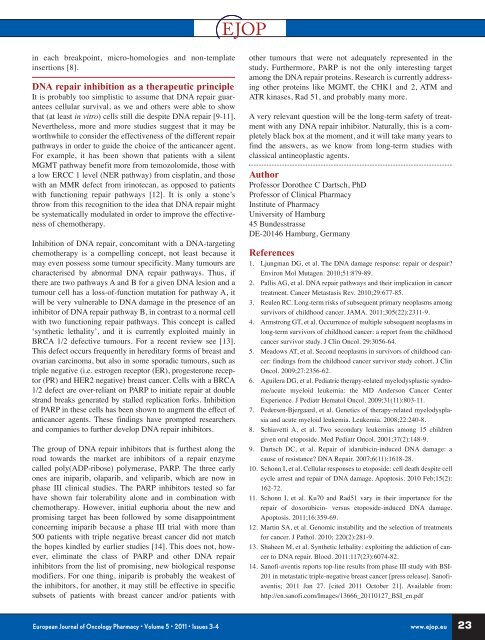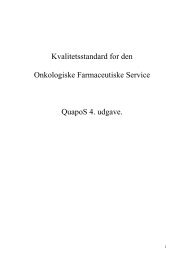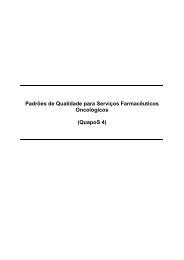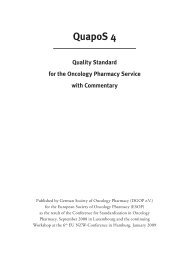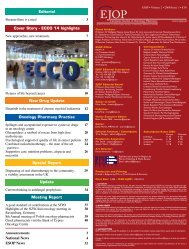Editorial Cover Story ESOP/NZW 2011 Congress Report Oncology ...
Editorial Cover Story ESOP/NZW 2011 Congress Report Oncology ...
Editorial Cover Story ESOP/NZW 2011 Congress Report Oncology ...
You also want an ePaper? Increase the reach of your titles
YUMPU automatically turns print PDFs into web optimized ePapers that Google loves.
in each breakpoint, micro-homologies and non-template<br />
insertions [8].<br />
DNA repair inhibition as a therapeutic principle<br />
It is probably too simplistic to assume that DNA repair guarantees<br />
cellular survival, as we and others were able to show<br />
that (at least in vitro) cells still die despite DNA repair [9-11].<br />
Nevertheless, more and more studies suggest that it may be<br />
worthwhile to consider the effectiveness of the different repair<br />
pathways in order to guide the choice of the anticancer agent.<br />
For example, it has been shown that patients with a silent<br />
MGMT pathway benefit more from temozolomide, those with<br />
a low ERCC 1 level (NER pathway) from cisplatin, and those<br />
with an MMR defect from irinotecan, as opposed to patients<br />
with functioning repair pathways [12]. It is only a stone’s<br />
throw from this recognition to the idea that DNA repair might<br />
be systematically modulated in order to improve the effectiveness<br />
of chemotherapy.<br />
Inhibition of DNA repair, concomitant with a DNA-targeting<br />
chemotherapy is a compelling concept, not least because it<br />
may even possess some tumour specificity. Many tumours are<br />
characterised by abnormal DNA repair pathways. Thus, if<br />
there are two pathways A and B for a given DNA lesion and a<br />
tumour cell has a loss-of-function mutation for pathway A, it<br />
will be very vulnerable to DNA damage in the presence of an<br />
inhibitor of DNA repair pathway B, in contrast to a normal cell<br />
with two functioning repair pathways. This concept is called<br />
‘synthetic lethality’, and it is currently exploited mainly in<br />
BRCA 1/2 defective tumours. For a recent review see [13].<br />
This defect occurs frequently in hereditary forms of breast and<br />
ovarian carcinoma, but also in some sporadic tumours, such as<br />
triple negative (i.e. estrogen receptor (ER), progesterone receptor<br />
(PR) and HER2 negative) breast cancer. Cells with a BRCA<br />
1/2 defect are over-reliant on PARP to initiate repair at double<br />
strand breaks generated by stalled replication forks. Inhibition<br />
of PARP in these cells has been shown to augment the effect of<br />
anticancer agents. These findings have prompted researchers<br />
and companies to further develop DNA repair inhibitors.<br />
The group of DNA repair inhibitors that is furthest along the<br />
road towards the market are inhibitors of a repair enzyme<br />
called poly(ADP-ribose) polymerase, PARP. The three early<br />
ones are iniparib, olaparib, and veliparib, which are now in<br />
phase III clinical studies. The PARP inhibitors tested so far<br />
have shown fair tolerability alone and in combination with<br />
chemotherapy. However, initial euphoria about the new and<br />
promising target has been followed by some disappointment<br />
concerning iniparib because a phase III trial with more than<br />
500 patients with triple negative breast cancer did not match<br />
the hopes kindled by earlier studies [14]. This does not, however,<br />
eliminate the class of PARP and other DNA repair<br />
inhibitors from the list of promising, new biological response<br />
modifiers. For one thing, iniparib is probably the weakest of<br />
the inhibitors, for another, it may still be effective in specific<br />
subsets of patients with breast cancer and/or patients with<br />
other tumours that were not adequately represented in the<br />
study. Furthermore, PARP is not the only interesting target<br />
among the DNA repair proteins. Research is currently addressing<br />
other proteins like MGMT, the CHK1 and 2, ATM and<br />
ATR kinases, Rad 51, and probably many more.<br />
A very relevant question will be the long-term safety of treatment<br />
with any DNA repair inhibitor. Naturally, this is a completely<br />
black box at the moment, and it will take many years to<br />
find the answers, as we know from long-term studies with<br />
classical antineoplastic agents.<br />
Author<br />
Professor Dorothee C Dartsch, PhD<br />
Professor of Clinical Pharmacy<br />
Institute of Pharmacy<br />
University of Hamburg<br />
45 Bundesstrasse<br />
DE-20146 Hamburg, Germany<br />
References<br />
1. Ljungman DG, et al. The DNA damage response: repair or despair?<br />
Environ Mol Mutagen. 2010;51:879-89.<br />
2. Pallis AG, et al. DNA repair pathways and their implication in cancer<br />
treatment. Cancer Metastasis Rev. 2010;29:677-85.<br />
3. Reulen RC. Long-term risks of subsequent primary neoplasms among<br />
survivors of childhood cancer. JAMA. <strong>2011</strong>;305(22):2311-9.<br />
4. Armstrong GT, et al. Occurrence of multiple subsequent neoplasms in<br />
long-term survivors of childhood cancer: a report from the childhood<br />
cancer survivor study. J Clin Oncol. 29:3056-64.<br />
5. Meadows AT, et al. Second neoplasms in survivors of childhood cancer:<br />
findings from the childhood cancer survivor study cohort. J Clin<br />
Oncol. 2009;27:2356-62.<br />
6. Aguilera DG, et al. Pediatric therapy-related myelodysplastic syndrome/acute<br />
myeloid leukemia: the MD Anderson Cancer Center<br />
Experience. J Pediatr Hematol Oncol. 2009;31(11):803-11.<br />
7. Pedersen-Bjergaard, et al. Genetics of therapy-related myelodysplasia<br />
and acute myeloid leukemia. Leukemia. 2008;22:240-8.<br />
8. Schiavetti A, et al. Two secondary leukemias among 15 children<br />
given oral etoposide. Med Pediatr Oncol. 2001;37(2):148-9.<br />
9. Dartsch DC, et al. Repair of idarubicin-induced DNA damage: a<br />
cause of resistance? DNA Repair. 2007;6(11):1618-28.<br />
10. Schonn I, et al. Cellular responses to etoposide: cell death despite cell<br />
cycle arrest and repair of DNA damage. Apoptosis. 2010 Feb;15(2):<br />
162-72.<br />
11. Schonn I, et al. Ku70 and Rad51 vary in their importance for the<br />
repair of doxorubicin- versus etoposide-induced DNA damage.<br />
Apoptosis. <strong>2011</strong>;16:359-69.<br />
12. Martin SA, et al. Genomic instability and the selection of treatments<br />
for cancer. J Pathol. 2010; 220(2):281-9.<br />
13. Shaheen M, et al. Synthetic lethality: exploiting the addiction of cancer<br />
to DNA repair. Blood. <strong>2011</strong>:117(23):6074-82.<br />
14. Sanofi-aventis reports top-line results from phase III study with BSI-<br />
201 in metastatic triple-negative breast cancer [press release]. Sanofiaventis;<br />
<strong>2011</strong> Jan 27. [cited <strong>2011</strong> October 21]. Available from:<br />
http://en.sanofi.com/Images/13666_<strong>2011</strong>0127_BSI_en.pdf<br />
European Journal of <strong>Oncology</strong> Pharmacy • Volume 5 • <strong>2011</strong> • Issues 3-4 www.ejop.eu<br />
23


